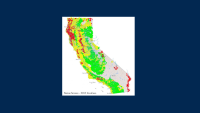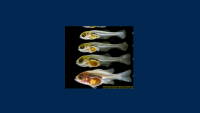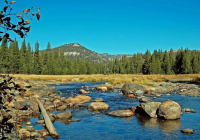
|
Migration of Fall River rainbow trout |
The purpose of this study is to better understand the spawning migration and timing of rainbow trout in the spring-fed Fall River of Northern California. |

|
Conservation of inland fish biodiversity |
Knowledge of species' spatial distributions is crucial to the identification and prioritization of watersheds in need of restoration. Coupled with species' status, the presence and or absence of species can indicate biologically diverse vs. depauperate areas. |

|
Sacramento Perch Pond Restoration and Reintroduction Project |
This project synthesizes existing knowledge on Sacramento perch survival, identifies potential refuge habitats, and develops strategies for their reintroduction while addressing ecological and institutional barriers. |

|
Modeling green sturgeon movement and population change in Central California |
This project aims to develop an individual-based model of threatened green sturgeon in California’s Sacramento River to simulate how climate change and water management — such as altered flows, passage, and temperature — affect their population dynamics, habitat use, and movement. |

|
Resiliency of California fishes |
This project advances models of stream baseflow and evaluates native fish sensitivity to flow variability across California, integrating improved hydrologic predictions, fish-flow analyses, and long-term monitoring data to guide sustainable water management and conservation of native freshwater species. |

|
California Salmon Thiamine Deficiency Research and Mitigation |
This project investigates thiamine deficiency in California Chinook and coho salmon, linking dietary shifts toward northern anchovies to reproductive failure and neurological dysfunction, while developing monitoring and mitigation strategies to protect endangered populations. |

|
Tracking Critical Habitats with Isotope Diaries in Fish |
This project uses chemical markers in salmon otoliths and eye lenses to reconstruct detailed, time-resolved habitat histories and quantify the role of key environments, particularly floodplains, in the survival of endangered and natural-origin Chinook salmon in the Sacramento River. |

|
Using Ancient Salmon Bones to Reveal Key Drivers for Recovering Modern Populations |
This project reconstructs 6,000 years of Chinook salmon life history, habitat use, and resilience to climate change by analyzing archaeological otoliths, vertebrae, and ancient DNA, providing critical historical context to guide modern conservation and management in California’s Sacramento River watershed. |

|
Salmon Life History Diversity in Natural and Regulated Rivers |
This project investigates how environmental variability, water management, and climate extremes shape juvenile salmon life history strategies and survival, using monitoring data and otolith chemistry to inform conservation of winter-run Chinook and support population resilience in a changing climate. |

|
Fall River Trout |
This project studies the Fall River as a climate-resilient cold-water refuge, examining how its spring-fed flows support rainbow trout populations during extreme droughts in Northern California. |









